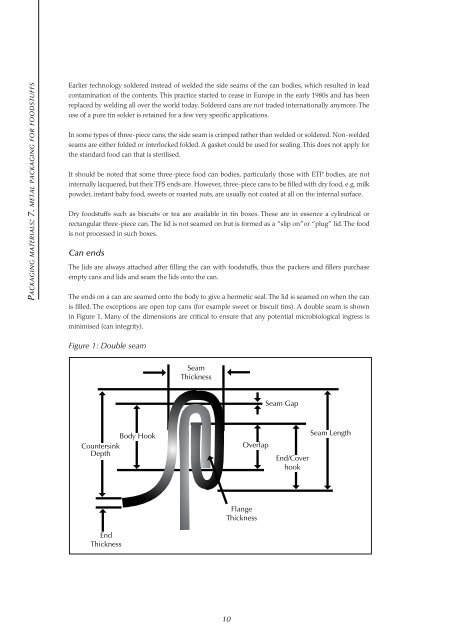Pa c k a g i n g ma t e r i a l s: <strong>7.</strong> m e t a l pa c k a g i n g f o r f o o d s t u f f sEarlier technology soldered instead of welded the side seams of the can bodies, which resulted in leadcontamination of the contents. This practice started to cease in Europe in the early 1980s and has beenreplaced by welding all over the world today. Soldered cans are not traded internationally anymore. Theuse of a pure tin solder is retained <strong>for</strong> a few very specific applications.In some types of three-piece cans, the side seam is crimped rather than welded or soldered. Non-weldedseams are either folded or interlocked folded. A gasket could be used <strong>for</strong> sealing. This does not apply <strong>for</strong>the standard food can that is sterilised.It should be noted that some three-piece food can bodies, particularly those with ETP bodies, are notinternally lacquered, but their TFS ends are. However, three-piece cans to be filled with dry food, e.g. milkpowder, instant baby food, sweets or roasted nuts, are usually not coated at all on the internal surface.Dry <strong>foodstuffs</strong> such as biscuits or tea are available in tin boxes. These are in essence a cylindrical orrectangular three-piece can. The lid is not seamed on but is <strong>for</strong>med as a “slip on” or “plug” lid. The foodis not processed in such boxes.Can endsThe lids are always attached after filling the can with <strong>foodstuffs</strong>, thus the packers and fillers purchaseempty cans and lids and seam the lids onto the can.The ends on a can are seamed onto the body to give a hermetic seal. The lid is seamed on when the canis filled. The exceptions are open top cans (<strong>for</strong> example sweet or biscuit tins). A double seam is shownin Figure 1. Many of the dimensions are critical to ensure that any potential microbiological ingress isminimised (can integrity).Figure 1: Double seamSeamThicknessSeam GapBody HookCountersinkDepthOverlapEnd/CoverhookSeam LengthEndThicknessFlangeThickness10
Classic endsThe classic end, normally used <strong>for</strong> food rather than beverages, is circular and most have circular ridges,which are expansion rings to allow <strong>for</strong> any changes in volume of the food during the thermal processing.For classic ends, TFS or ETP are normally used.Easy-open endsEasy-open ends (EOEs) are becoming ever more popular. Not only do they avoid the inconvenienceof having to use a can opener but also, due to their design, they are much safer with fewer lacerationscaused by the edges of the jagged end produced by a can opener.All DWI beverage cans, regardless of whether they are steel or aluminium, have an aluminium end.There are many types of ends used <strong>for</strong> food cans. The full aperture easy-open end (FAEOE) is gainingwidespread acceptance. In this type of end, all of the end of the can lid is effectively removed during theopening process, unlike a beverage end where only part is opened and stays on the end or is separatedfrom the end, to enable the contents to be poured from the can. Ends <strong>for</strong> food cans can be made fromaluminium, ETP or TFS. Whilst designs and <strong>metal</strong>s may differ, the principles of manufacture are similar:The <strong>metal</strong> is coated. A shell is punched and then the EOE shape is fabricated, including the score linethat weakens the <strong>metal</strong> sufficiently to allow its fracture and easy opening. A tab is then attached tothe end by a rivet. This rivet is drawn from the can end (to ensure microbiological integrity) – a mostdemanding de<strong>for</strong>mation process – to ensure the integrity of the end. A repair coat can be used to repairthe damage caused by scoring and <strong>for</strong>ming the rivet.Pa c k a g i n g ma t e r i a l s: <strong>7.</strong> m e t a l pa c k a g i n g f o r f o o d s t u f f sEasy-peel ends are also beginning to affect the market <strong>for</strong> easily removable ends.Drums and pailsDrums and pails are in essence large three-piece steel cans. They are supplied empty, with bungs in the“lid” <strong>for</strong> the customer to fill. They are not subjected to any processing when filled. Drums tend to refer tolarger volume containers of typically 100–220 l whilst pails normally refer to 5–25 l containers. There aredifferent grades of drums depending upon the intended contents and method of transportation.AerosolsAerosol cans are mainly used <strong>for</strong> non-food applications, such as cosmetics, body care products, insecticidesand lubricants. Only a few <strong>foodstuffs</strong>, such as canned whipping cream, are packaged in an aerosol.Aerosol cans are either three-piece or two-piece. In essence, the principles of two- or three-piece canmanufacture apply, whilst the ends differ and are fitted as a unit. All three-piece aerosols are made fromsteel. The main difference between aerosol and can manufacturing is with the two-piece aerosol, knownas a monobloc. The aerosol container is manufactured of aluminium by impact extrusion. The diameterof the open end is reduced (swaging) to receive the spray nozzle and an internal lacquer is spray applied.Typical rates of production are about one fifth of those of a DWI B&B can process, partly due to theparameters surrounding the application of the internal spray.Based on two-piece aerosol can technology, a recent development is an aluminium bottle <strong>for</strong>beverages.11

















